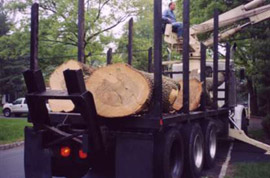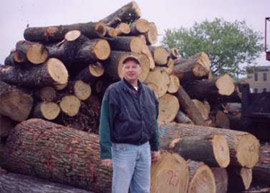Recycling Trees
Air Date: Week of November 21, 2003
When most urban and suburban trees around the country fall or are cut down, they end up in the dump. One man in New Jersey came up with a plan to rescue these trees and turn them into “value-added” products. Living on Earth's Cynthia Graber reports.
Transcript
GELLERMAN: It’s Living on Earth. I’m Bruce Gellerman, and coming up: a dog problem of Olympic proportions. But first, New Jersey poet Joyce Kilmer penned what some consider the worst poem ever written. It begins: “I think that I shall never see a poem as lovely as a tree.” Well, despite the overwrought hyperbole, trees are lifesavers, providing clean air, helping retain the soil, and shade. And for another New Jersey resident, when a tree dies it’s just the beginning of its usefulness. Living on Earth’s Cynthia Graber reports.
[WHIR OF CHAINSAW]
WARMBOLD: I’m looking at some great ash out of this log.
GRABER: Donald “Stubby” Warmbold stares up about thirty feet, where a young wood-cutter dangles from a tree, chainsaw in hand. A pale yellow arc of wood dust floats behind the worker as he slices into the three-foot wide trunk. In many places around the country, the wood from a tree such as this would get dumped into a landfill. But six-foot tall Stubby Warmbold has different plans for this ash tree.
WARMBOLD: There's no center rot, I mean, the only reason it's coming down – it's a perfectly healthy tree – they're widening the driveway. But it's a good log. It's a money log [LAUGHTER].
GRABER: A money log, as Warmbold calls it, is a tree he takes off the hands of tree removal services and gives a new life. Warmbold runs Citilog, a company dedicated to saving urban trees from the dump. He says there’s no shortage of uses for recycled wood.
[CHAINSAW]
WARMBOLD: We'll make furniture out of this, railway ties, pallets, depending on what the grade is, if there's rot, flooring...
GRABER: Working with trees is nothing new to Stubby Warmbold. He worked in timber years ago in Canada, and then in the U.S. Pacific Northwest. When the move to save the endangered spotted owl and reduce logging put him out of business, Warmbold starting looking for work closer to home in New Jersey. A friend who ran a tree removal company wanted to avoid the disposal fee at the landfill, so he asked if Warmbold could use trees he had cut down. This gave Warmbold the idea for his next venture.
WARMBOLD: I just looked at all these logs - there’s a lot of logs here. It just – it just came upon me. I wasn’t a rocket scientist. I just looked at a log and I realized the potential of the log.
 Trees coming down to make room for a driveway in Summit, New Jersey. (Photo: Cynthia Graber) Trees coming down to make room for a driveway in Summit, New Jersey. (Photo: Cynthia Graber) |
|||||
WARMBOLD: I called them up. I didn't even know it was an Amishman, I’d never spoken to an Amishman before. And it was a sawmill. I called him up, he says “yeah, well, I'm a little too big for that,” and he mentions Samuel Peachy. GRABER: Samuel Peachy is an 80-year-old Amish mill-owner who’s been milling wood for decades. Not only did he take Warmbold’s wood, but he also introduced him to local craftsmen who now make wood products that Citilogs sells. Warmbold didn’t realize it at the time but the Amish turned out to be a perfect fit for his business. WARMBOLD: So when I come to them I give them work, and it's good work and it's work that they like. And for me, it gives me manufacturing capabilities without having to have a plant. I have huge manufacturing capabilities. We can expand our production, we can reduce our production, because they're all independent contractors. GRABER: In the normal life of a city tree, metal and ceramic may become embedded in the trunk. Larger mills worry that these impurities might destroy their equipment. But the Amish back-to-basics, small-scale approach allows them to avoid this common problem. And while some municipalities have programs to mulch trees or chop them for firewood to keep them out of landfills, Warmbold thinks his model of making high-value products out of these old logs is a much better use of beautiful hardwood. [DINGING OF CAR STARTING] GRABER: It’s early morning, and Warmbold gets into his white Ford pick-up to begin the day’s drive. WARMBOLD: I live in this thing [LAUGHTER]. I live in it – sleep in the back, drive all day. GRABER: Today, he’s heading two hours west into the rural Pennsylvania Juniata county. A heavy mist has settled around the dark green mountains. The pick-up, which runs partly off biodiesel, seems to know how to navigate these narrow lanes almost on its own. Warmbold’s collaboration with the Amish has been so successful that they recently opened a new production facility to process the recovered wood. [BUZZING OF MACHINERY IN SHOP] WARMBOLD: And it's a brand new shop and it's about a week old. And we're just breaking it in. We have all the tools necessary for a modern cabinet making shop, from plane carriers to edge sanders to belt sanders to panel saws to hand tools, all the hand tools.
|

 Stubby Warmbold at his log yard. (Photo: Cynthia Graber)
Stubby Warmbold at his log yard. (Photo: Cynthia Graber)



